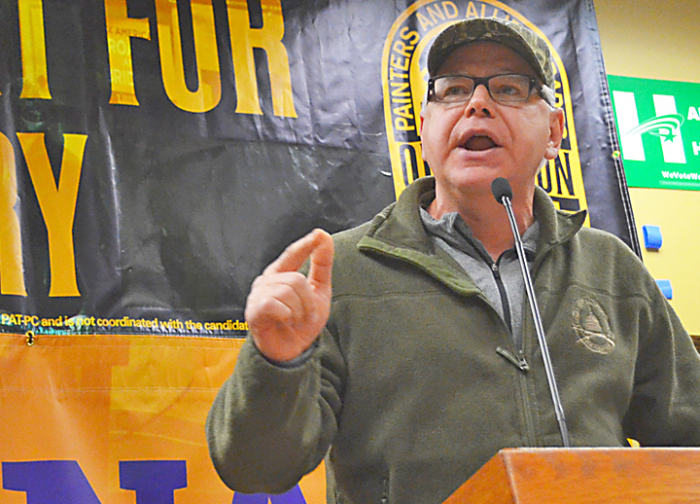

Share
When Tim Walz addressed delegates to the Minnesota Building Trades’ annual convention in Duluth over the summer, the labor-endorsed candidate for governor did not mince words, giving the labor leaders and union stewards a message to take back to their union halls.
“People will tell you, ‘I’m not into politics,’” Walz said. “You tell them too damn bad because politics is into you.”
“The choice is Walz or Wisconsin when it comes to organized labor. It’s that simple.”
Walz was referencing the string of attacks Wisconsin union members saw on their wages, benefits and freedom to join together after Republicans, led by Gov. Scott Walker, seized total control of the state’s government eight years ago.
It began with Act 10, which gutted the collective bargaining power of teachers and other public-sector workers in 2011. Four years later Walker signed a right-to-work bill, weakening the bargaining power of all unions.
And last year, Wisconsin Republicans unleashed a pair of attacks on union tradespeople and their quality of life. One law banned local governments from entering into project labor agreements, which establish fair wage and benefit standards on construction projects. Another repealed the state’s prevailing-wage law, which builds fair wages into the public construction bidding process.
But it hasn’t just happened in Wisconsin.
“We’ve got to keep Minnesota from going the way of Michigan, Indiana, Wisconsin, Alabama, Kentucky, New Mexico – all states that since 2012 have gone right to work, have banned project labor agreements and have eliminated prevailing wage,” said Tony McGarvey, government affairs liaison for District 82 of the International Union of Painters and Allied Trades.
Already, the effects of Wisconsin’s anti-worker agenda are noticeable even here in Minnesota.
In Rochester, where construction of a Destination Medical Center has helped create a booming job market for tradespeople, Painters Local 681 rep Scott Parker said he sees an “influx of union workers coming over from Wisconsin,” where they would earn less for doing the same work.
“If we go right to work, where do we go? North Dakota? South Dakota? Wisconsin? Iowa?” Parker said. “We are an island surrounded by right to work. Where will I go to make the money I’m making now?”
Prevailing wage: A case study
No issue better represents what’s at stake for construction workers in this election than prevailing wage.
Minnesota’s prevailing wage laws establish wage floors in regions across the state that contractors must agree to meet in order to win bids on publicly funded construction projects. The principle behind the law is that workers should be able to afford to live in the area where they find work.
Opponents argue that repealing the law would save taxpayers money, and as a former state legislator, it’s an argument Carly Melin, now executive director of the Minnesota State Building and Construction Trades Council, has heard plenty of times.
“We know repealing prevailing wage doesn’t save the public any money,” Melin said. “The contractor still makes the money, it’s just the workers who see less of it in their paychecks.”
The vast majority of peer-reviewed academic studies on prevailing wage support Melin’s claim, according to a report issued earlier this year by researchers at the nonpartisan Midwest Economic Policy Institute and Colorado State University-Pueblo.
The report concludes that if Minnesota joins its neighbors in repealing prevailing wage, tradespeople stand to lose their wage advantage and more. “Minnesota’s prevailing wage law supports self-sufficient construction workers,” the report’s authors, Frank Manzo and Dr. Kevin Duncan, concluded.
By comparing data from seven Upper Midwest states, the report found Minnesota tradespeople are doing better than their counterparts in Iowa, Nebraska, North Dakota, South Dakota and Wisconsin – states without strong (or any) prevailing wage laws. Because Minnesota still has prevailing wage on the books, construction workers here see 5.2 percent higher incomes, are more likely to have health and pension benefits, and are less likely to rely on food stamps.
Threat to apprenticeship
In fact, rather than driving up public construction costs, the researchers found Minnesota’s prevailing wage law actually delivers significant value to the state in terms of workforce development.
By setting a higher wage floor, the law guarantees local union contractors a fair shake at publicly bid construction projects. And when Building Trades union members are working, a portion of their wages are deducted to help fund their unions’ apprenticeship training programs, which provide world-class training opportunities to thousands of Minnesotans without any government funding.
Without prevailing wage, the authors conclude, Minnesota contractors who participate in apprenticeship training programs would lose more bids to “fly-by-night contractors from neighboring states with low wages, resulting in fewer training opportunities (not to mention shoddier infrastructure).
That’s the reality Building Trades union members are now facing in states like Wisconsin and Michigan – labor strongholds where “we never would have thought they would repeal prevailing wage,” Melin said. And it’s a threat Minnesota’s Building Trades unions are hoping to keep at bay by electing Tim Walz governor Nov. 6.
“If it can happen in Wisconsin and it can happen in Michigan, then it can happen in Minnesota,” Melin said. “We have a lot at stake.”

